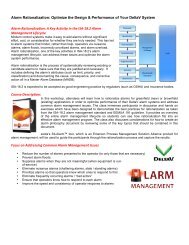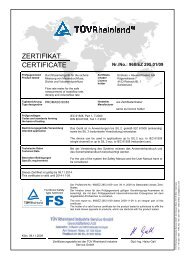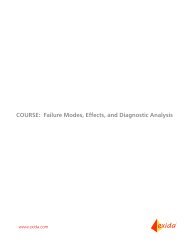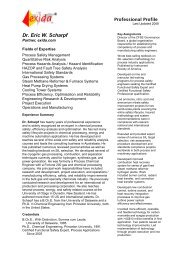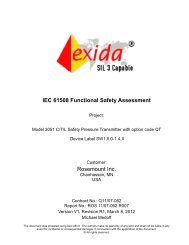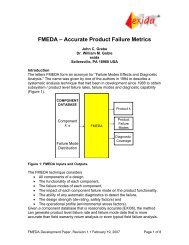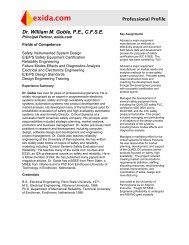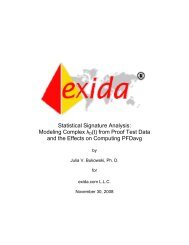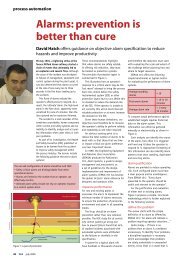Download a sample of the exida alarm philosophy template
Download a sample of the exida alarm philosophy template
Download a sample of the exida alarm philosophy template
Create successful ePaper yourself
Turn your PDF publications into a flip-book with our unique Google optimized e-Paper software.
<strong>exida</strong> consulting LLC<br />
Customer Company Name Alarm Philosophy Document<br />
process <strong>of</strong> suppressing (bypassing) an <strong>alarm</strong> using a permit system. In <strong>the</strong> maintenance stage, <strong>the</strong> <strong>alarm</strong> does not<br />
perform its function <strong>of</strong> indicating <strong>the</strong> need for <strong>the</strong> operator to take action.<br />
The <strong>philosophy</strong> should describe <strong>the</strong> recommended elements <strong>of</strong> <strong>the</strong> procedure to remove an <strong>alarm</strong> from service and<br />
return an <strong>alarm</strong> to service. Depending on <strong>the</strong> <strong>alarm</strong> priority, classification, and time to respond, <strong>the</strong> act <strong>of</strong> taking<br />
an <strong>alarm</strong> out <strong>of</strong> service may necessitate internal administrative procedures to effectively mitigate <strong>the</strong> hazard during<br />
<strong>the</strong> period which <strong>the</strong> <strong>alarm</strong> is out <strong>of</strong> service. These procedures need to provide clear guidance on who must be<br />
notified and what o<strong>the</strong>r indication <strong>the</strong> operator will utilize to avert <strong>the</strong> existing abnormal situation for <strong>the</strong> specified<br />
<strong>alarm</strong>. The <strong>alarm</strong> priority and consequence may be severe enough to require management approval before <strong>the</strong><br />
operator removes <strong>the</strong> <strong>alarm</strong> from service. Typically <strong>the</strong> <strong>philosophy</strong> contains only broad guidance on <strong>the</strong> use <strong>of</strong><br />
removing an <strong>alarm</strong> from service and references an operating procedure that specifies <strong>the</strong> method and<br />
authorization requirements to remove an <strong>alarm</strong> from service.<br />
The operator may take an <strong>alarm</strong> out <strong>of</strong> service, or suppress <strong>the</strong> <strong>alarm</strong> for an extended period <strong>of</strong> time, using an<br />
authorization process. Alarms are typically taken out <strong>of</strong> service for repair. Out-<strong>of</strong>-service requirements for <strong>alarm</strong>s<br />
shall be determined by <strong>the</strong> classification <strong>of</strong> <strong>the</strong> <strong>alarm</strong> and <strong>the</strong> class requirements as specified in this <strong>alarm</strong><br />
management <strong>philosophy</strong>.<br />
Alarms that will be compromised for extended durations shall be examined to determine whe<strong>the</strong>r an alternative<br />
<strong>alarm</strong> is necessary. If an interim <strong>alarm</strong> is necessary, it shall adhere to <strong>the</strong> <strong>alarm</strong> class and MOC requirements.<br />
A bypass permit is required to take an <strong>alarm</strong> out <strong>of</strong> service. The permit must document:<br />
a) The date <strong>the</strong> <strong>alarm</strong> is taken out <strong>of</strong> service.<br />
b) The reason <strong>the</strong> <strong>alarm</strong> is taken out <strong>of</strong> service.<br />
c) The name <strong>of</strong> <strong>the</strong> requester.<br />
d) The name <strong>of</strong> <strong>the</strong> authorizer.<br />
Before returning out-<strong>of</strong>-service <strong>alarm</strong>s to <strong>the</strong> operational state, operators shall be notified to ensure <strong>the</strong>y are<br />
aware <strong>of</strong> <strong>the</strong> returning <strong>alarm</strong> and <strong>the</strong> removal <strong>of</strong> <strong>the</strong> interim methods.<br />
A list <strong>of</strong> all out-<strong>of</strong>-service <strong>alarm</strong>s should be readily available to <strong>the</strong> operator at all times. The operator should<br />
review <strong>the</strong> list at shift handover. Authorization must be obtained each day <strong>the</strong> <strong>alarm</strong> is out <strong>of</strong> service.<br />
9.6 Alarm System Problem Detection and Resolution<br />
The <strong>alarm</strong> <strong>philosophy</strong> may include guidance on <strong>the</strong> <strong>alarm</strong> system chronology, a logbook that records <strong>the</strong> problems<br />
in <strong>the</strong> process and in <strong>the</strong> <strong>alarm</strong> system identified by <strong>the</strong> monitoring system, <strong>the</strong> actions taken to resolve those<br />
problems, and <strong>the</strong> results <strong>of</strong> <strong>the</strong> actions. This document or file captures <strong>the</strong> business value <strong>of</strong> <strong>alarm</strong> management<br />
practices. There is no set format for an <strong>alarm</strong> chronology.<br />
9.7 Operator Feedback and Resolution Work Practices<br />
Define <strong>the</strong> workflow practices for operators to document <strong>alarm</strong> system issues, provide feedback, and to check on<br />
<strong>the</strong> status <strong>of</strong> actions.<br />
Exida Page 69 <strong>of</strong> 93<br />
Main Offices<br />
Service Centers<br />
Sellersville, PA, USA Munich, Germany Switzerland United Kingdom Houston, TX, USA Hong Kong<br />
Calgary, AB, Canada South Africa Singapore Mexico <strong>the</strong> Ne<strong>the</strong>rlands New Zealand/Australia Brazil<br />
Rev 2/2011



